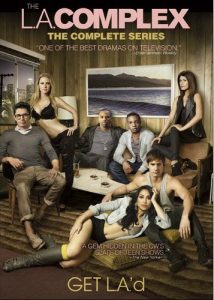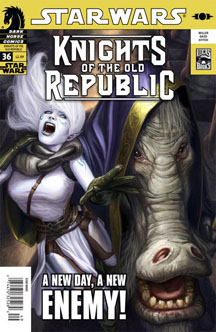Nearly three full years into its run, “Knights of the Old Republic” finally wraps up the “framing of Zayne Carrick” arc. It’s satisfying in the sense that Zayne’s name is cleared and he can now move freely throughout the galaxy without fear of arrest (at least for that particular crime), but it also illustrates a common problem with stories about Jedi Masters and justice in the “Star Wars” universe: namely, that they are above the law. As I review issues Issues 29-37 (2008-09), I’m not sure if I should give credit to John Jackson Miller for illuminating this problem, or if I should be peeved that he doles out a light sentence to Master Lucien Draay and his cohorts.
In the epilogue of Issue 35, Lucien and the other surviving Covenant members who killed four innocent Padawans and framed Zayne form a kinder, gentler version of the Covenant on a remote planet. Lucien is wearing a wrap around his eyes, as if he clawed them out as penance. I like that Lucien and Zayne team up to defeat Haazen, the Draay family ward who was secretly manipulating everyone with the dark side, in the dramatic finale of “Vindication” (Issues 32-35). But I don’t like the way Miller portrays it. Off-panel, Lucien and Zayne agree to fake out Haazen by pretending to fight each other. Readers never see the actual pact, nor does Zayne get so much as an apology from Lucien.
Justice for renegade Jedis has always been a controversial issue in “Star Wars.” Most notably, Kyp Durron destroys an entire populated planet in the “Jedi Academy Trilogy,” and faces no legal repercussions. The issue of how to imprison Jedi might be a practical factor. We can assume Barriss Offee was convicted of the bombing and imprisoned at the end of “The Clone Wars” Season 5 (as the Republic had wrongly put Ahsoka on trial for that crime), but how the Republic successfully secures dark-side Jedi is unclear. I picture Magneto’s special cage in the “X-Men” films.
And even arresting Jedi can be nearly impossible for non-Force-users. The attempted arrest of Palpatine in “Episode III” must be undertaken by Jedi Masters, because — even if the Jedi themselves ultimately failed — Republic police officers would have no hope of detaining any Force-user who doesn’t voluntarily submit to it, particularly one as powerful as Darth Sidious.
Still, it’s an undeniable double standard that Lucien and his Covenant members get to live freely (even if they see it as a life of penance) when a common citizen who killed four innocent people would be imprisoned. I imagine HoloNet debates in the Old Republic consist of GFFA libertarians advocating for equal treatment under the law and hearing the straw-man rebuttal of “But not ALL Jedi are bad.” I hope Miller, the foremost expert in Earth history and politics among “Star Wars” scribes, will revisit the Old Republic’s unequal treatment of Jedis under the law.

But he has other tricks up his sleeve in “Prophet Motive” (36-37), when he brings Jarael and Rohlan – backgrounded throughout Zayne’s vindication arc — back to the fore. It appears that Jarael uses the Force to rescue herself and Rohlan. However, Rohlan is the one who (rather randomly) encourages Jarael to use the Force to save them, and it occurs to me that we’ve never seen under Rohlan’s Mandalorian mask. I think Rohlan, in fact, is the Force user.
This batch of issues both illustrates and overcomes a criticism I have levied on “Knights” since the beginning: That it doesn’t feel enough like a sequel to “Tales of the Jedi.” The wildly varying art styles is a big part of the problem. I’m not sure if “Exalted” (29-30) is supposed to be funny or serious: Zayne and Gryph get viciously roughed up by the muscular guardians of the Covenant’s Sith artifacts, yet Bing Dazo’s art makes the comedic elements of Miller’s script pop, creating an odd dichotomy. “Turnabout” (31), drawn by Alan Robinson, sets a serious tone as Zayne and Gryph infiltrate Coruscant, but “Vindication” then bounces back and forth between Dazo’s humor-enhancing style and Brian Ching’s rough and grim work.
The problem isn’t necessarily that one art style or another is right for a given arc, it’s the inconsistency within a single storyline. The contrast of a serious story and humorous art can be effective, as shown in “Prophet Motive.” Dazo illustrates Gryph’s daring scheme to dress up as a law professor and infiltrate the crazy white-collar criminal world of futures trading, where an increasingly unhinged Chevin (think Ephant Mon from Jabba’s Palace) runs the show.
I must give Miller credit, though, for Haazen’s arc in “Vindication.” I like how the author pauses the action to reveal Haazen’s backstory in a multi-page flashback, a technique often employed by John Ostrander on “Legacy” (and something that should have been done to show Lucien and Zayne’s secret team-up). Haazen’s turn to the dark side happened in the Sith War, when he was manipulated by Dossa, a female of the always-grinning Nautolan species (think Kit Fisto) who is a lackey of “Tales of the Jedi: The Sith War” villain Exar Kun. Dossa gives Haazen ugly but effective prosthetics after purposely injuring him in a blast, thus sealing Haazen’s dark-side rage the way cybernetic parts are wont to do in “Star Wars.” A Sith artifact then shielded Haazen’s dark nature, allowing him to live in close proximity to the Covenant for decades.
We also learn that Lucien’s father was killed in the Sith War, which is also where Lucien began to develop his twisted view that young Jedi warriors are expendable (even via outright murder) if it’s in service to a better future. I don’t know if Miller intended me to sympathize with Lucien and his Covenant by the end of “Vindication,” but – lacking a scene of Zayne receiving an apology — I still hate Lucien’s guts. On the other hand, I’m digging all the good guys, and I particularly want to find out Rohlan’s identity and the shrouded reason behind the Republic-Mandalorian war in upcoming stories.

